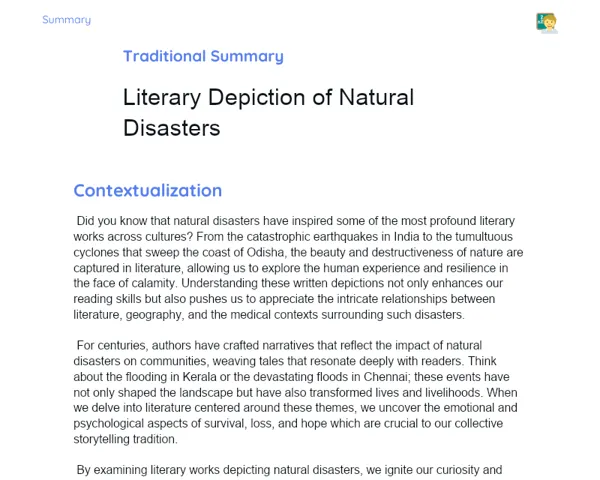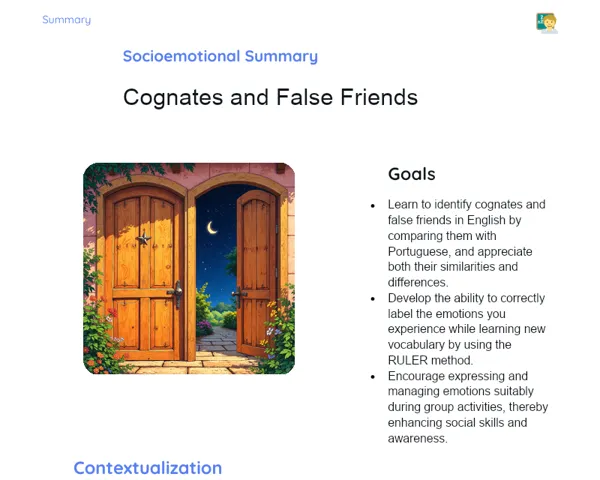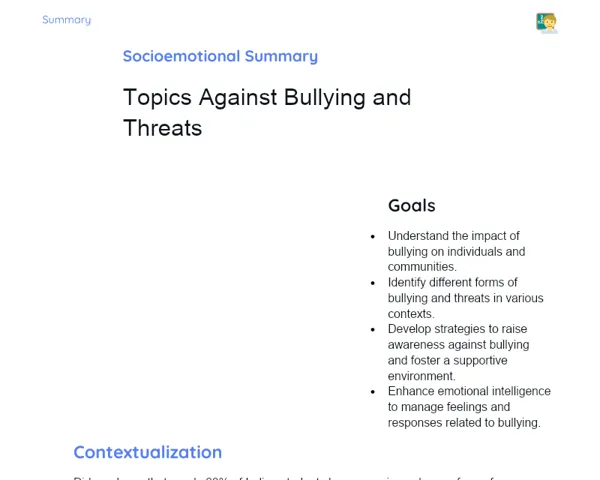Summary Tradisional | Pronouns and Adjectives: Demonstratives
Contextualization
Demonstrative pronouns and adjectives are vital parts of the English language, helping us pinpoint and specify objects or individuals based on their proximity in space and time. This understanding is essential for effective communication. For instance, 'this' and 'these' are used for items that are nearby, whereas 'that' and 'those' refer to items that are further away.
Grasping the distinctions between these pronouns and adjectives is key to avoiding confusion, especially in global interactions. Knowing whether to use 'this book' or 'that book', or 'these apples' or 'those apples', enables us to describe objects and situations accurately, which is critical for effective and clear communication.
To Remember!
Demonstrative Pronouns
Demonstrative pronouns in English are essential for indicating where something is and how specific it is in relation to the speaker. The four main demonstrative pronouns are 'this', 'that', 'these', and 'those'.
We use 'this' for a singular object or person that is near the speaker, like in 'This is my pen.' 'These' refers to a plural form of 'this', applicable to multiple items or people close by, as in 'These are my books.'
Conversely, 'that' denotes a singular item or person that is further away, for example, 'That is your car.' 'Those' is simply the plural form of 'that', referring to multiple items at a distance, such as 'Those are your shoes.'
The choice between 'this', 'that', 'these', and 'those' depends on how close or far away the object or person is from the speaker and whether we are addressing something singular or plural.
-
'This' is for something nearby (singular).
-
'These' is for multiple things nearby (plural).
-
'That' is for something distant (singular).
-
'Those' is for multiple things distant (plural).
Demonstrative Adjectives
Demonstrative adjectives in English are similar to demonstrative pronouns, but they are placed directly before a noun to specify which object or person is being discussed. They play a crucial role in helping to identify and clarify within a sentence.
For instance, 'this book' uses 'this' as a demonstrative adjective to indicate a specific book close to the speaker. Likewise, 'those houses' indicates specific houses that are further away, where 'those' functions as a demonstrative adjective. The key difference is that pronouns can replace nouns, while demonstrative adjectives accompany them.
Using demonstrative adjectives correctly is important for ensuring clarity in communication. Saying 'this book' signifies a specific book that is close by, while 'that car' points to a specific car that is farther away.
Demonstrative adjectives are crucial for accurately defining the objects or people being referred to, thus preventing any misunderstandings.
-
Demonstrative adjectives come before a noun.
-
'This book' specifies a particular book that is near the speaker.
-
'Those houses' specifies houses that are further away.
-
Demonstrative adjectives provide clarity on which object or person is being referred to.
Usage Rules
The rules for using demonstrative pronouns and adjectives are straightforward yet essential for effective communication. The primary guideline is that 'this' and 'these' refer to objects or individuals that are nearby, while 'that' and 'those' pertain to those that are more distant.
For example, 'this pen' represents something close (singular), while 'these books' indicates multiple items that are near (plural). In contrast, 'that car' denotes something farther away (singular), and 'those houses' refers to multiple items that are at a distance (plural).
It's also crucial to remember that proximity can be both physical and temporal. For instance, 'this morning' refers to a morning that is close in time, while 'that day' relates to a day that feels far away temporally.
Correctly applying these rules is vital to ensuring clarity in communication, particularly when location and time are critical.
-
'This' and 'these' are for objects that are near.
-
'That' and 'those' are for objects that are far away.
-
Proximity can refer to distance or time.
-
Making the right choice avoids misunderstandings.
Practical Examples
To enhance understanding and application of demonstrative pronouns and adjectives, let’s look at some practical examples. These will aid in solidifying your knowledge and practicing these concepts in various situations.
Take the sentence 'This is my book.' In this case, 'this' serves as a demonstrative pronoun indicating the specific book that is near the speaker. In contrast, in 'That is your car.', 'that' indicates a specific vehicle that is further away.
When we incorporate demonstrative adjectives, the structure of the sentence slightly alters. For example, 'This book is mine.' uses 'this' to specify a book that is nearby. Similarly, 'Those apples are yours.' applies 'those' to indicate multiple apples that are further away.
Practicing with varied examples helps students grasp how to use demonstrative pronouns and adjectives correctly in different contexts.
-
'This is my book.' - Shows a close book.
-
'That is your car.' - Indicates a car that is distant.
-
'This book is mine.' - Demonstrative adjective for a close book.
-
'Those apples are yours.' - Demonstrative adjective for distant apples.
Key Terms
-
Demonstrative Pronouns: Words that indicate the location and specificity of objects or individuals relative to the speaker ('this', 'that', 'these', 'those').
-
Demonstrative Adjectives: Words placed before a noun to clarify which object or person is being referred to ('this book', 'those houses').
-
'This': Indicates an object or person nearby (singular).
-
'These': Indicates multiple objects or individuals close to the speaker (plural).
-
'That': Indicates an object or person that is further away (singular).
-
'Those': Indicates multiple objects or individuals that are distant (plural).
Important Conclusions
In this lesson, we studied demonstrative pronouns and adjectives in English, focusing on words like 'this', 'that', 'these', and 'those'. We examined their roles in indicating the location and specificity of objects or people concerning the speaker in both physical and temporal contexts. The importance of understanding and applying these terms accurately for clear communication was highlighted.
We also provided practical examples to demonstrate the use of demonstrative pronouns and adjectives, bridging the gap between theory and practice. We analyzed how the choice between 'this' and 'that', or 'these' and 'those', can alter a sentence's meaning, thus preventing misunderstandings—especially crucial in a multicultural context.
We reinforced the relevance of this knowledge, stressing that accurate use of demonstrative pronouns and adjectives is fundamental for efficient communication in daily life. We encourage students to delve deeper into the topic and practice these elements in various settings to strengthen their learning.
Study Tips
-
Practice forming sentences with different demonstrative pronouns and adjectives. For example: 'This book', 'Those shoes'.
-
Read English texts and identify demonstrative pronouns and adjectives, marking examples for later discussion.
-
Engage in gap-fill exercises and sentence transformations to solidify your grasp of the usage rules for demonstrative pronouns and adjectives.



